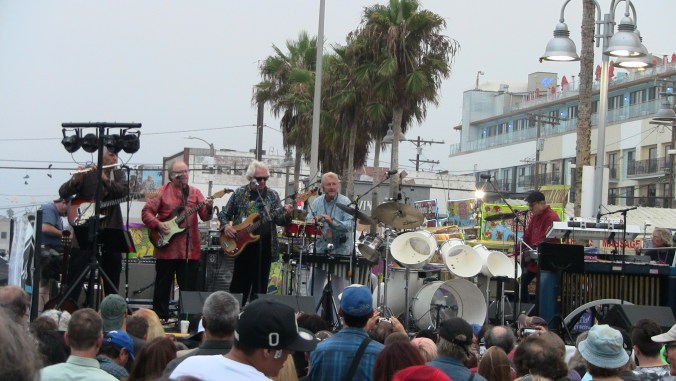
Celebrants at the MAPS conference, April 2017
Walking around the Marriott hotel ballroom in downtown Oakland, amongst swirling images of hallucinogen inspired paintings, dozens of clinical study bulletin boards, and bean-bag chairs, I had a natural flash-back. The colorful denizens of this conference reminded me of my psychedelic-infused college days in the 70s at nearby UC Berkeley, except this time they came from all over the world and were all generations from Millennials to Boomers. Except, in this crowd, you couldn’t tell the straights from the freaks. But times have changed, most overtly in the toking space outside of the Marriott Hotel in downtown Oakland, where bongs and vapes were freely passed around in the open.
Coinciding with this year’s 50th anniversary of the Summer of Love and prohibition of LSD, the worldwide community of psychedelic therapists, researchers, and enthusiasts emerged from the shadows. I joined over three thousand at the quadrennial MAPS (Multi-disciplinary Association for Psychedelic Studies) conference in Oakland, CA last April. From the large conference halls to the smaller workshop rooms to the marketplace of psychedelic art, I experienced a new confident exuberance. No longer confined to secretive latter-day hippies or the laboratories, psychedelics came out this year. For this old Sixties psychonaut, it felt like reconnecting with my long-lost tribe. We spoke freely about inner journeys without couching personal stories in the third person or providing a lot of explanation.

Psychedelic inspired painting, MAPS
But more than a party, data dominated the conference. I attended several lectures that elucidated the therapeutic benefits of MDMA, ayahuasca, ibogaine, LSD, and cannabis. MDMA has shown promise in treating PTSD and addiction in numerous studies both here and abroad. First synthesized by Merck chemist Anton Kollisch in 1912, former Dow chemist Sasha Shulgin discovered its’ relaxing properties accidentally and used it as his evening cocktail. Soon it occurred to Shulgin that MDMA may be helpful with psychotherapy and shared it with therapist friends. Quickly spreading within that community, it proved too much fun to keep in the doctor’s office. Perfect for the 80s party culture, it became a staple of rave culture worldwide from Ibiza to Dallas. The genie had again escaped from the bottle. The liberated and joyful mood generally experienced attracted the attention of the DEA, placed MDMA in Schedule 1. Schedule 1 drugs are deemed to be of no medical use and pose serious health risks. Included in Schedule 1 are cocaine, heroin, cannabis, and MDMA. That effectively ended its use in therapy until MAPS associates began to use it with Iraq War vets suffering from PTSD.
The recent approval of MDMA (also known as Ecstacy, Molly, Adam, and dozens of other names) for study by the US Food and Drug Administration (FDA) for phase three clinical trials culminates a long struggle for scientific support of its efficacy. If these are successful, then the possibility is for doctor prescriptions with very narrow guidelines. If approved, it would have limited availability. But that is how medical marijuana opened, first approved twenty years ago in California the door for legal cannabis . Regardless, not only a new found respectability, but I noted a new honesty with researchers reporting the results of studies of psychedelics from Brazil to Israel some of which have not been met expectations. Seeking to not repeat the mistakes of the Sixties of overpromising the virtues of the drugs and incurring a the backlash from conservatives, MAPS and its executive director, Rick Doblin, proceed methodically .
Attending the MAPS conference was like visiting a long ago friend who had been on a long odyssey: She had changed, wiser and more nuanced, but still offered a familiar essence—freedom, expansion, and bliss. One thing has changed now, fellow-travelers include science and business types, along with the counter-culturalists, the artists, and the curious. Perhaps Doblin is on the right track and going through channels will lead to respectability. And that we can learn from the past, and treat these entheogens (god chemicals) with the respect and love they deserve.

RW enjoying a toke of the sacrament at the Marriott, April 2017. It took over forty years, but societal change is often slow









 LA’s original love-in followed the previous year’s police riot on the Sunset Strip. Heads were banged and many youths arrested, while protesting the demolition of a popular teen hang-out (Pandora’s Box). Immortalized in Steven Stills’ For What It’s Worth by Buffalo Springfield, the song announced a new, assertive attitude from teenagers. Rather than turning up the pressure, the police took a different tack at the Easter love-in a year later, very few arrests were made and even the Los Angeles Times gave a neutral, if muted report.
LA’s original love-in followed the previous year’s police riot on the Sunset Strip. Heads were banged and many youths arrested, while protesting the demolition of a popular teen hang-out (Pandora’s Box). Immortalized in Steven Stills’ For What It’s Worth by Buffalo Springfield, the song announced a new, assertive attitude from teenagers. Rather than turning up the pressure, the police took a different tack at the Easter love-in a year later, very few arrests were made and even the Los Angeles Times gave a neutral, if muted report.









 Alas, on that balmy Santa Monica night, after two songs the small guy, with wispy blonde hair who played those distinctive licks disappeared from the stage. The music continued, but Paul Kantner couldn’t continue, he’d made an appearance, but that was about it—a recent heart attack had taken its toll. Sadly, Kantner died this week at the age of 74 after another heart attack.
Alas, on that balmy Santa Monica night, after two songs the small guy, with wispy blonde hair who played those distinctive licks disappeared from the stage. The music continued, but Paul Kantner couldn’t continue, he’d made an appearance, but that was about it—a recent heart attack had taken its toll. Sadly, Kantner died this week at the age of 74 after another heart attack.




